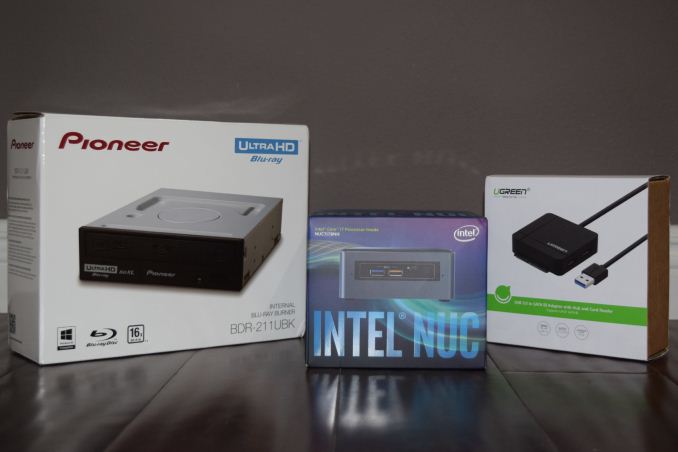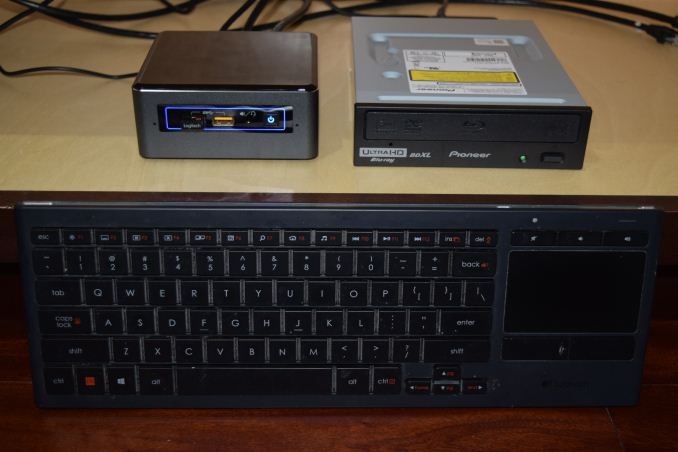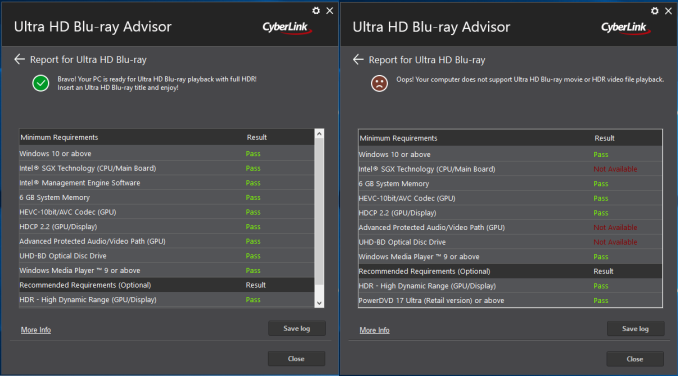A Budget Home Theater & PC Setup: 4K, HDR, UHD Blu-ray, and More
by Ganesh T S on December 26, 2017 8:30 AM ESTConfiguring a UHD Blu-ray Playback System
The rise in popularity of OTT streaming has coincided with a decline in the popularity of physical media formats such as Blu-rays. Irrespective of the market statistics, it is indisputable that the bitrates possible with the latter simply can't translated to OTT services. Bitrates usually directly correlate with video quality, though, beyond a certain point, it becomes very difficult to distinguish. HD audio formats such as Dolby Atmos, DTS-HD MA, Dolby TrueHD etc. are also yet to be widely adopted by OTT streaming services. On top of all these, Blu-rays are often treated as collectibles by some consumers.
UltraHD (UHD) Blu-rays (with their 4K resolution videos encoded in HEVC) were a bit slow to take off. On the PC front, the number of licensed software Blu-ray player vendors has come down from 3 (ArcSoft, Corel, and CyberLink) to just CyberLink alone. PowerDVD 17, with UHD Blu-ray support, was released in April 2017. The hardware requirements were quite specific, and we decided to pass up on a hands-on review at that time.
While reviewing the Intel NUC7i7BNH, I realized that it came with support for SGX, one of the primary requirements for PowerDVD 17 to play back UHD Blu-rays. I also remembered that the BIOS of the ASRock Beebox-S 7200U had a SGX option. Both of these systems also had a LSPCon on board to support HDMI 2.0 with HDCP 2.2 capability. Pioneer launched the BDR-211UBK in March, but, had specifically indicated that KBL-U was incompatible. However, based on our discussions with both CyberLink and Intel, we decided to give the drive a try by connecting the internal SATA ODD using a compact SATA-USB bridge.
The Pioneer BDR-211UBK and the UGREEN SATA-USB Adapter Combine to Make the Intel NUC7i7BNH a UHD Blu-ray Player
We looked up Amazon for a compact bridge and chanced upon a versatile UGREEN adapter. In addition to supporting the SATA drive, it also had a couple of USB 3.0 Type-A extension ports and a microSD reader. This made sure that the optical drive would not completely take over the USB port in the host system.
Using an Internal Drive without an Enclosure is not an Issue if the Setup is Tucked Out-of-Sight
After setting up the hardware and configuring the BIOS appropriately in the two systems, we installed the Management Engine components. The next step was to confirm that the system and allied components were correctly set up for UHD Blu-ray playback with HDR. CyerbLink provides the Ultra HD Blu-ray Advisor tool for this purpose. It also helpfully points out missing ME components or mis-configured BIOS options. Even though we were aware that the Zotac ZBOX MAGNUS EN1080K doesn't pass the requirements check (no SGX, iGPU inactive), we did try out the tool on it also.
The CyberLink Ultra HD Blu-ray Advisor (L: ASRock Beebox-S 7200U, R: Zotac ZBOX MAGNUS EN1080K)
Even though it is possible that the Zotac EN1080K might enable SGX in a future BIOS release, the use of the Intel GPU is probably disabled at the board level. This means that there is no protected audio/video path for secure decoding of the UHD Blu-ray streams. Given that there is no talk of UHD Blu-ray support from NVIDIA Pascal, consumers shouldn't keep their hopes up regarding the possibility of UHD Blu-rays getting played back on NVIDIA Pascal-equipped systems. Coming back to the results of the UHD BD Advisor tool, we find that the two KBL-U systems pass all the checks. We purchased a retail copy of the Planet Earth II UHD Blu-ray for testing out our setup.













191 Comments
View All Comments
pjcamp - Wednesday, December 27, 2017 - link
The one thing you didn't mention is what keyboard you are using. I haven't been happy with any of the ones I've used so a little help would be, well, helpful.DIE_BETA_SOY_BOYS - Wednesday, December 27, 2017 - link
"budget"What a useless article
watersb - Wednesday, December 27, 2017 - link
I, for one, enjoyed this write-up very much. I have been out of the AV Zone for a decade, but as a musician and PC enthusiast I was curious to see how this played out.A write-up like this: I have done similar tests for audio-only gear, and it took 50 hours of work. Maybe I'm too slow.
And finally, this may be a dumb question, but for a Home Theater setup, what keyboard/pointing device work best for you? I need to get something. My ten-year-old Gyration Mouse/keyboard has died. Not kidding. It was great. Backlit keyboard that can see duty as primary PC keyboard preferred.
What are you all using?
Shaan1969 - Thursday, December 28, 2017 - link
watersb, Logitech K830 (~$50) is the best one with long lasting rechargeable battery with back-lit option. I have been using it for the last few years without any issues.watersb - Tuesday, January 2, 2018 - link
Thanks! Was on my list, at $50 the price has come down a bit since last I looked.Shaan1969 - Thursday, December 28, 2017 - link
Ganesh, thank you for taking time to write up a great article. I thoroughly enjoyed reading it and planning to upgrade my HTPC accordingly this weekend.Everyone's definition of budget is different and I wish readers focus on the content of the article rather than accusing the writer.
milkod2001 - Thursday, December 28, 2017 - link
good read, you might want to also upgrade those curtains granny bought and insisted to use when on last visit while you are in this upgrading process.UtilityMax - Friday, December 29, 2017 - link
This situation with the high cost and pain-in-the-butt involved in 4K HTPC setup compared to buying Playstation 4, Xbox, or Roku reminds me of a similar situation that happened with home routers in the late 1990s. As the Internet connections started becoming more affordable (be it dialup or broadband) a whole lot of geeks wanted to come up with solutions so that their entire home network could connect to the internet with just one IP address. A whole lot of them turned to setting up a dedicated PC running Linux to act as their gateway to the internet for the purpose of firewalling and network address translation (NAT). This made even people originally not interested in using Linux start exploring the Linux systems because back in the 1990s Linux distributions were way better than Windows or Macs at advanced networking stuff.Then an interesting thing happened. A cheap Taiwanese-made router with firewall, NAT, and a 4-5 port 100Mbps switch became available for something like 50 bucks around year 1999-2000. This has near instantly killed the concept of setting up manually a dedicated PC to act as your router gateway. Today you don't even have to buy a dedicated router, because your broadband cable modem probably already comes integrated with wifi, router, NAT, firewall, switch, and all that (mine does).
The same way we are observing the situation where various set top boxes or "sticks" costing under a couple of hundred bucks, gaming consoles, and even smart TVs have pretty much near eliminated the whole point of building a dedicated HTPC. HTPC is basically a dinosaur.
Combine that with the fact that most people out there still don't give a damn about 4K content, don't have 4K TVs, don't have access to 4K cable (duh!), and don't want to pay for either 4K BD discs or for high speed internet conections required for 4K streaming, and you see why building your own HTPC is going to be just like banging your head against a wall.
rapster - Friday, December 29, 2017 - link
Totally agree. The NVIDIA Shield has - for me - made the PC moot. This time around I based my system on a Shield that streams from the internet and Synology disk array, a “budget” receiver, a BD player, some great speakers, and an old 1080p TV. Not even sure what use a PC would serve.mikato - Thursday, January 18, 2018 - link
Sounds good. I’ll have to check out the Shield. But you can’t bring this to a friend’s house and plug into their TV or home theater. I want that too :)